The Green Horse section provides practical information on managing environmentally sustainable horse properties, readers stories and tips, as well as advice and articles from equestrian experts in their fields.
Aug Sept 24
Vol 46 No 2
In this issue of The Green Horse you will find the following articles
SHORT VERSUS LONG GRASS
by Erika Gough
Understanding the effects of grazing on short grass versus longer grass is crucial for any
horse owner, but particularly for those who have horses with endocrine issues or a history of
laminitis (usually caused by endocrine issues).
Protect Your Chooks From Bird Flu.
Australia’s largest outbreak of avian influenza resulting in the culling of nearly two million chickens this year in NSW,
Victoria and the ACT. While those with a few chickens on the property might be reassured about their own supply of eggs and the health of their chooks it’s important to be be aware of the current bird flu outbreak and to take steps to reduce the risk as backyard chickens have been
affected by this highly infectious virus. Green Spaces
Lowering Obesity Related Cancer
A University of Queensland-led study has found a link between exposure to gardens and green spaces and a lower risk of being
diagnosed with obesity-related cancer.
ROUNDUP CASE DISMISSED
A landmark class action lawsuit alleging the weed killer Roundup caused cancer has been thrown out of Australia’s Federal
Court.
Retaining Rainfall and Controlling Run Off by Wendy Elks
In Australia water is a precious
commodity and every property owner can make changes to ensure that what rain falls on their ground, stays there.
SPRING IS HERE
by Country Park Herbs
This time of the year is when your horse's body will be waking up after the sluggishness of winter. it is the perfect time to rejuvenate, clean out and establish new habits.
WIN A YEAR'S SUBSCRIPTION...
share your equine property management tips and each issue one reader will win.
Send ideas to -
The Green Horse Support <enquiries@hoofbeats.com.au>


PREVIOUS ARTICLES
Available on line
June July 24
SMALL BLOCKS BIG DREAMS
by Karen O'Keefe
An example of how sme small landcaregroups also deliver Equine Landcare related activities.
April/May 24
STOP THE ROT IN YOUR FENCE POSTS
by BOUNCE BACK HORSE FENCE
Timber posts tend to rot at the base. It is a normal process in the breakdown of the wood, but it can be postponed, giving a longer life to the fence post.
February March 24
CAN A SOIL TEST TELL YOU WHAT IS IN YOUR PASTURE?
by Nerida Richards - Feed XL
A definite recommendation for horse owners is to have their pasture and hay tested so they get a much more accurate idea of what their horses are eating.
August September 23
CREATING AND USING THE SACRIFICE PADDOCK
Functional areas that are safe and useable are essential, with an area set aside as a ‘sacrificial’ area or paddock considered by many horse owners to be an invaluable component of their property’s set up and design.
June July 23
CREATING A WEED MANAGEMENT PLAN - your property your weeds.
by Rhiannon Brown, Envirapest
Keep it Simple as making a weed management plan doesn’t have to be like studying for that master’s degree or passing your driving test for the first time either.
Apriil/May 23
SIMPLE FEED BUDGET
by Belinda Taylor
Although most horse owners are nervous at the prospect of creating a budget, a few quick
calculations can give you the power to compare prices and alternatives that can reduce your horses’ feed
costs, without impacting on their health and wellbeing.
February/March 23
CROFTON WEED KILLS HORSES
by Angela Davison
If you have this weed on your property then it is best to not have any horses in the paddock until such time as you can eradicate it.
December/January 22 23 PROPERTY PLANNING
-Working with your property- not against it.
by Teele Worrell
Property planning is about
using your property effectively
and efficiently and sometimes
starting with a clean slate.
October/November 22
WHAT IS EQUESTRIAN LANDCARE
by Teele Worrell
Part 1 In a series in which Teele will explore what equine landcare is, and why it benefits equine landholders
August/September 22
THE IMPORTANCE OF GROUND COVER
by Belinda Taylor
Ground cover, whether it be dead grass, weeds, hay, or mulch is the insulating layer that protects your soil from the extremes of temperature and erosion.
June/July 22
SOLAR FOR YOUR ARENA
Environmentally-friendly solar lighting for your arena will allow you to use your arena for longer, and as energy from the sun is free it is therefore an ideal long-term solution for powering lights. Jeff Florence from Blackfrog Solar, Queensland suggsted some solar tips.
April/May 22
MAKING THE MOST OF MOSQUITO CONTROL
by Rhiannon Brown - Envirapest
Climate change that has brought high temperatures, more rain and increases in humidity will provide ideal breeding grounds for the many species of mosquitoes, including those that spread the Japanese Encephalitis virus (JEV).February/March 2022
February/March 22
SUSTAINABLE DEWORMING
by Sophie Fletcher
There has been a relatively big shift in deworming treatment strategies in recent years, due to increasing levels of worm resistance to the chemicals we have been using for decades to control them, resulting in a lot of confusion among horse owners.
December/January 21/22
ARE YOU PREPARED FOR THE FIRE SEASON
In the many areas where horse owners live this season's fire preparation should be well underway; if you’ve not already started preparing your property for summer then now is the time to do so.
October/November21
SNAKE UNIVERSAL ANTIVENOM
The good news is that there is no longer any need for a snake to be identified to administer antivenom. A universal antivenom is now used that covers the five genus of snake that will cause serious harm or death.
August/September 21
BEAT THE BINDI
by Rhiannon Brown - Envirapest
The prickly weeds that grow on our properties across Australia usually have long classical Latin names, are often known by a variety of common names in different localities but are regularly called very rude names when we happen to stand on one (or a dozen) or when they find our hands as we are dislodging tangles in the horse’s mane or tail.
June July 21
BARN OWLS by Wendy Elks
A silent partner in rodent control.
Non-toxic pest management is the most humane and ecologically sustainable way of bringing nature back into some kind of balance during non-plague times.
April/May 21
LOVELY LAWNS
by Rhiannon Brown - Envirapest
On a horse property there always seems to be hectares of grass, but we all have that little bit of lawn we want to look luscious all year round.
It could be the entrance to the stables, laneways bordering the driveway, that little ‘special’ snack paddock or you could even dream of a beautiful green arena. So, how do we achieve this?
Feb/March 21
STABLE DANGERS
by Elizabeth Tollarzo
They say that horses are accidents-waiting-to-happen as they are inclined to find every conceivable way to injur themselves, usually just before a competition. Being aware of potential dangers in the stable - and addressing these - may help aleiviate injury.
Dec/Jan 20/21
HORSES AND HONEY BEES-
Can they share space on the property?
by Wendy Elks
Oct/Nov 20
SOLAR-POWERED PRODUCTS
by Celine Bønnelykke
In previous issues we have discussed the economics of setting up a solar-driven property, but if finances don’t stretch to installation of the whole package, there are ways to ease into the solar-world.
Aug/Sept 20 THE HIDDEN DANGERS IN OUR PADDOCK.
by Elizabeth Tollarzo
Horses love to run, play, buck and then run again and we often, through lack of risk assessment or management practices, place them in areas that are fraught with dangers.
JUNE JULY 20 GOING SOLAR ON THE HORSE PROPERTY Where to put your panels Part 2
Once you have selected what solar system best suits your needs, then you need to look at how you can maximise the advantages.
APRIL MAY 20 GOING SOLAR ON THE HORSE PROPERTY Part 2
Once you have selected what solar system best suits your needs, then you need to look at how you can maximise the advantages.
FEB/MARCH 20 ANTS AWAY
by Mark Brown Envirapest
So, what can you do to deter ants from your house and your stables??
DJ19/20 KEEPING SNAKES OUT OF THE STABLE by Wendy Elks
Snakes may be protected under Wildlife regulations in Australia, and they may be great for keeping the mice and rats down, but do we want to find them in our stables near our horses and pets?
ON19 - TERMITES- common myths
by Rhiannon Brown, Envirapest
Your house and stables are looking wonderful this spring, but do you know what is happening inside the walls of your brick or timber building?
AS19 - OUCH THAT HURTS
by Catherine Bird for Country Park Saddlery
The extent of the swelling is usually an indication of the severity of the infection or injury and the cause needs to be established before giving herbs.
JJ19 - MANAGING PASTURE
by Rhiannon Brown, Envirapest Healthy pasture means healthy horses.
A/M19 - STOP THOSE WEEDS
Property biosecurity
by Rhiannon Brown, Envirapest
Putting simple precautionary steps into place can make it tough for weeds to get a hold on your equine paradise.
|
  
  


“People talk about how they want their horse to lose weight so they put it in a paddock with, ‘nothing in it’. The ‘nothing’ they refer to is usually very short, stressed grass of one or two
species, with a decent spread of weeds popping up for good measure.
Somewhat ironically, it is horses with endocrine issues that are often the ones purposely put on short, overgrazed grasses with the objective of keeping weight off.
There are many reasons why short grasses cause issues:
• Short grass is constantly trying to grow. Therefore it will store its sugars and starches (Non-Structural Carbohydrates or NSCs) to prepare for improved growing conditions. Growing conditions won’t improve as your horse will continually keep eating it down, but the sugars will stay there.
• Because NSCs are predominantly at the baseof the plant, each mouthful has a high NSC:fibre ratio. Typically the sugars are lower, and fibre higher, towards the top of the grasses, so the longer the grass, the less sugar and higher in fibre it is. A high fibre, low sugar diet is what a horse’s gastrointestinal system is designed to eat.
• The higher the grass’s fibre content, the lower the NSC intake will be.
• Eating longer grass means the horse has to chew more. This not only slows down their intake, but increases saliva production. Saliva helps to buffer stomach acid and helps to prevent ulcers and other gastrointestinal issues.
• A healthy (non-metabolic) horse eats until they have a specific amount of fibre in their stomach. Eating grass with a high-sugar and low fibre ratio means a horse consumes a lot of high-sugar grass before it feels satiated. This is why you might see horses with ad-lib hay standing around in the shade more than you will see horses with short grass doing the same. Horses with access to high-fibre hay can go and eat, then rest. Horses that need to eat all day to feel full will rest less.
• Because a horse’s front teeth (incisors) work so well, they can eat enough to stay fat on grasses that are 3cm - 4cm. Ponies can do the same on grasses that are even shorter (1cm - 2cm).
• Grasses grown specifically for lawns have their growth points very close to the ground so the plant can cope with being kept constantly short. These grasses have been selected specifically for this. Overgrazing results in only the ‘lawn’ type grasses surviving - so the result is a monoculture; just one or two species of grass. In addition, lawn type grasses are typically not ideal grasses for your horses to be eating a lot of.
• Horses are more likely to pick up sand while grazing short grass than they are on longer grass.
Propert y owners who want to take care of
their paddocks should also keep in mind that:
• Short grass plants have short root systems that cannot reach far down in the soil for nutrients. A short root system results in much less organic matter in the soil, causing soil compaction and poor drainage (not to mention less carbon sequestration).
• Short, sparsely grassed areas in a paddock quickly turn to mud in wet weather and become dusty very quickly in dry weather. Both lead to soil erosion.
• Short grass plants are not as able to outcompete certain weeds as longer grasses are.

How long is short ?
Clients need to fill in a form to get a diet consultation and I ask for
a description of their pasture as part of the process (both written and photographic). I have been astonished at the difference between what they tell me the grass is like, and what it is actually like. A lot of owners describe grass that’s around 3cms long as, ‘heaps of really good grass’. Because of this misunderstanding of what good grass is, they then don’t offer any additional hay. I end up having a lot of discussions with clients about grass. Sometimes we chat more about pasture and hay than the diet itself which is understandable as grass is complicated!
Short grass is generally shorter than 5cm (2.5 inches). However you need to look at the average height across your pasture as you will (hopefully!) have several species of grass available to your horses. There may also be areas they use as toilets, which they won’t eat unless they’re almost starving. While 5cms is pretty short, in reality, on many horse properties, the grasses are as short as 1 or 2 cm.
Many horse owners think a paddock full ofgrass that is 5cm long would be regarded as too long. At 5cm, the plant is just about
reaching the stage where it has 2 to 3 leaves, and it can now start to make a rapid recovery, using its stored sugars/starches for growth; at less than 5cm it becomes stressed.

Why is longer grass better for horses?
Longer grasses are healthier and typically not stressed (so they have less NSCs). Taller pasture plants have a higher fibre-to-sugar
ratio than short grass. As mentioned earlier, this is ideal for a healthy gastrointestinal tract. Longer grass typically allows for more biodiversity (i.e. less monoculture). They have a longer and thicker root system, which results in more healthy nutrients being brought up from deeper layers in the soil.
Longer/thicker roots equal better soil protection, which means less mud or dust. Obviously this is good for the ground and for
your horse (less mud is better for a slew of reasons), but it also means plants may be able to be grazed in wetter conditions for a longer period of time.
Longer grass also shades out and outcompetes many weed species. When the roots are longer the plant ‘trades’ some sugars for other nutrients such as amino acids. When
the grass is short and stressed, it hangs onto excess sugars.
The horse has to eat grass from the top; this means they need to eat the higher fibre, lower sugar part before it can get to the higher sugar part of the plant (at the bottom of the plant).
The need to chew the longer grass more creates saliva to buffer
stomach acid.
Horses also walk more when grazing longer, more diverse pastures as they seek out different plants. Essentially they are browsing,
not just grazing, this variety of eating pastures is good for them biomechanically.
Horses pick up their feet more if they live in paddocks with longer grasses, this is also beneficial biomechanically.
Why is longer grass better for your property?
• Longer grasses shade the soil in hot, dry conditions, which keeps it cooler and reduces evaporation. This, plus the increase in soil
organic matter, helps hold water in the soil for longer, which means your grass can keep growing even when it hasn’t rained in a while.
• Longer grasses provide a habitat for insects, small mammals/reptiles, and ground-nesting birds.
• With their longer/thicker root systems, taller grasses sequester more carbon than short grasses and even faster than trees! This
is improved when the plants are repeatedly grazed and then allowed to regrow (as part of a rotational grazing system), as it effectively pumps carbon into the soil.
• Taller pasture plants keep the soil warmer in cold weather.
How long is long?
In a rotational grazing system of land management, the grass is regarded as tall enough to resume grazing when it is approximately 15cm, or just before it goes to seed. When the grass plants have been grazed down to an average height of 5cm, horses should be removed and the grass given the chance to rest and recuperate.
Won’t free access to long grass make my horse fat/ter?
This answer to this question requires a more detailed answer and a whole other, very long article, and is dependent on many factors.
However, provided you do it sensibly, then in my experience, the answer is no.
Of course you can’t just let your horse have free access to endless lush, early spring grass, especially if you have high sugar grass species such as rye. If however, you have grasses that are lower in sugars such as fog, and/or you wait until it’s a little drier then your horse is less likely to gain weight, AND it’s a whole
lot better for your horse’s gut AND also for
the pasture itself.
If your horse has had its grazing restricted to overgrazed, short grasses for a long time (particularly if it also hadn’t had
access to hay) then you need to make a slow transition to longer grasses.
If you suddenly give your horse access to long, lush grass then they are very likely to gorge and then they will gain weight.
What about horses on agistment?
Having a horse on agistment makes things more difficult, but not impossible. Ask your agistment owner if you can rig up some temporary fencing (i.e. pigtails and tape) within your paddock to rest part of it, or set up a track system so you can have longer
grasses. Setting up a track next to your existing permanent fencing also encourages more incidental movement and means you
can restrict grazing at the height of spring and then allow your horse onto the longer grasses when it’s safe to do so. I suggest approaching them from a ‘paddock/pasture preservation’
point of view and use all the above reasons as to why it will be better for their land, as well as for your horse.
*Credit to the Equiculture website, which was used as a
resource for this article.

|